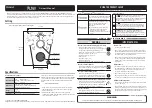
Goniometer
Probe Mounting
4
!
Probe (included) or with an optional second probe to measure two joints
simultaneously. You can use multiple sensors together to support even
more probes. The probe is easily attached to the body using the included
hook-and-loop mounting straps.
The Goniometer Probe consists of two arms and a potentiometer. As the
angle between the arms changes, the resistance of the potentiometer
changes. The Angle Sensor, connected to the probe, measures the
resistance of the potentiometer and converts it to an angle measurement.
The sensor also calculates the angular velocity and angular acceleration
from the rate at which the angle changes. The data is sent digitally to your
PASPORT interface at up to 100 samples per second.
The probe measures zero degrees (or radians) when it is
fully open. A clockwise rotation of the narrow arm relative
to the wide arm (as pictured) is measured as increasing
angle.
Probe Mounting
The mounting straps can be used in two ways. The easier method is to
place the straps on the limbs, then stick the probe to the outside of the
straps. For more secure attachment, tuck the probe arms inside the
overlapping portions of the straps.
When mounting the Goniometer probe, the wide and narrow arms of the
probe are interchangeable; the only difference will be the sign of the data
collected. Attach the wide arm of the probe to the subject’s upper arm when
used on the left elbow, and to the subject’s forearm when used on the right
elbow. This will result in a flexion of either joint measured as a positive
displacement. Similar reversals can be applied to knee and hip mounting.
Elbow
Place one strap around the
upper arm midway between
the elbow and shoulder.
Place a second strap around
the lower arm midway
between the elbow and wrist.
With the hand relaxed, bend
the elbow at a right angle.
Align the probe’s hinge with
the elbow. Attach one arm of
the probe to the subject’s upper arm parallel to the humerus.
Extend the elbow and attach the other probe arm parallel to the ulna. Flex
and extend the elbow a few times to check for proper alignment.
!"#$%
&"'(%)*+"#
!"#$%
&"'(%)*+"#
!"#$%
!"#$%
&'(%





































